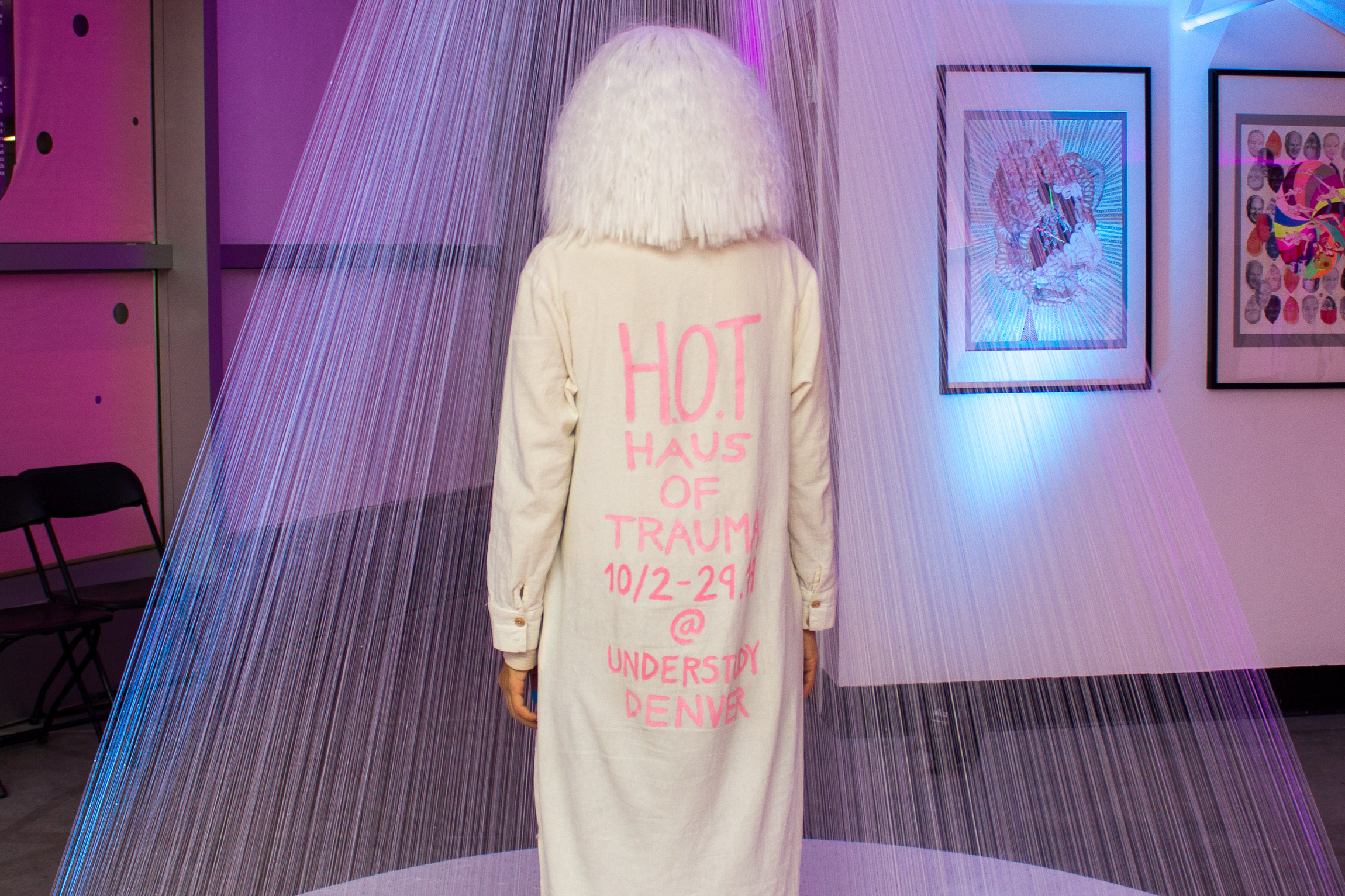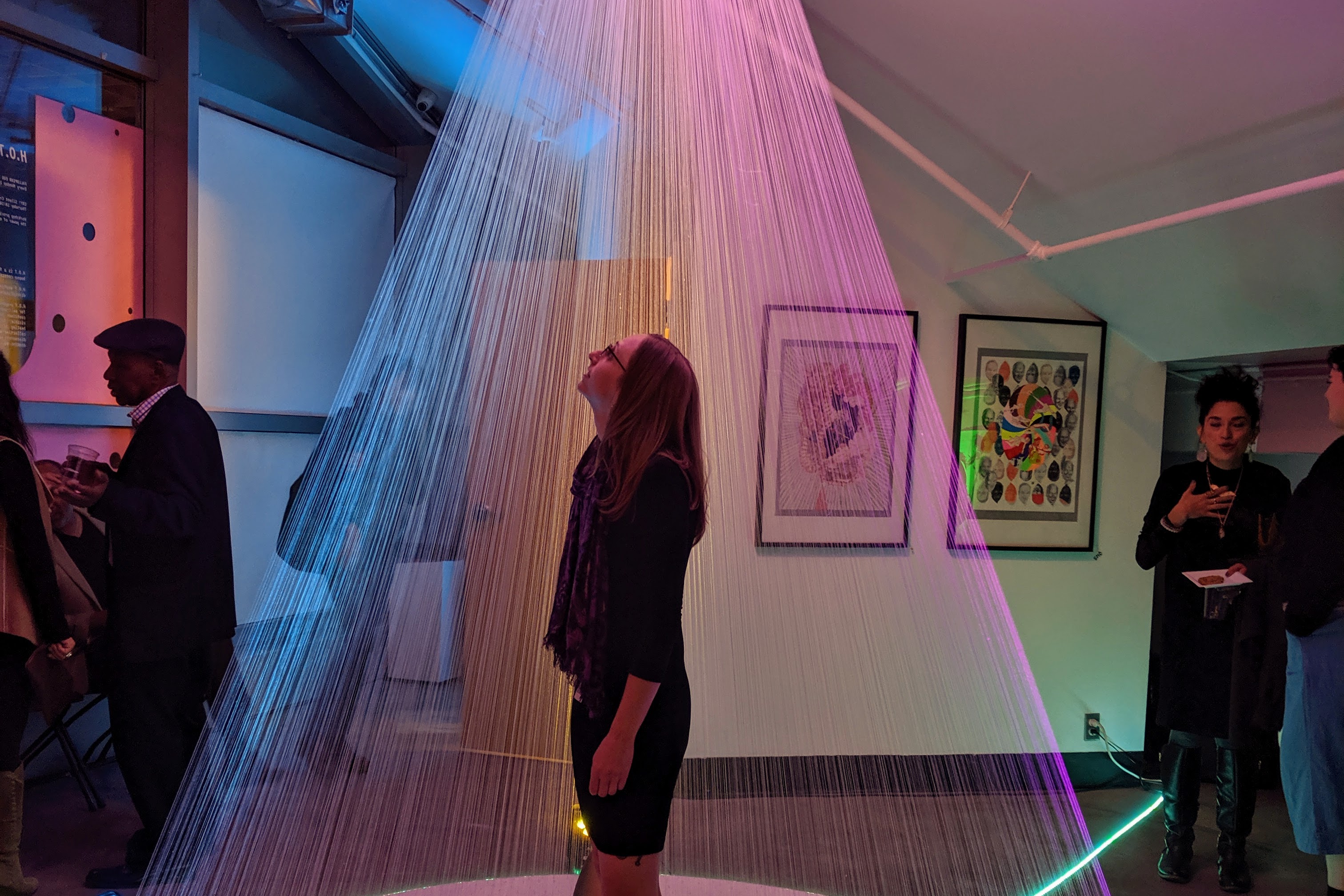The Haus of Trauma does exactly the opposite of what it sounds like. Instead of instigating horror, like you might imagine with that name during this month, Haus of Trauma is all about healing and positive transformation. Created from the mind of Mongolian-American artist Eriko Tsogo, Haus of Trama (or H.O.T for short) is a fictional world built inside the artistic incubator Understudy that acts as a “live-healing playhouse” that facilitates recovery from any kind of trauma through an imaginative re-birth.
This “live-healing playhouse” is a multilayered and multidisciplinary triumph, peppered with feminist innuendos and symbolism from Tsogo’s diverse background. It’s a mother temple, complete with a Uterus Altar in the center, accentuated by a perfect golden egg. The live-healing part comes from a variety of sources, not the least of which is just being inside the H.O.T.
Walking into this fictional world from the bustling one outside (and around the Convention Center), visitors are greeted first by pink wallpaper bespeckled with holes. It’s a shade of pink that calms the nervous system, that reminds us on a basic level of a womb. And it sets up the rest of the experience as one that is both intensely personal and universally understood.
For Tsogo, she approached the idea of the installation from a place of spiritual renewal. She wanted to create a space where she could heal from the five sexually traumatic experiences she has undergone, but also give others a place to heal from whatever ails them, whether it’s sexual or not. “America is experiencing trauma on a massive scale right now,” she commented, and for that matter, the entire world is too. Inside the space, four mirrors allow for personal reflection and to remind Tsogo and any visitor that healing from trauma requires self-reflection. Originally, there were five to represent the five ages of her sexual assaults, but one broke on opening day. Tsogo thought abut leaving the shattered pieces where they fell, but instead picked them up and didn’t replace the mirror. The symbolism in that is still too thick to dissect, but it speaks to the profundity of what she’s created. Every move made inside this little sanctuary feels significant, like healing ourselves should be a sacred experience done with intention.
For the first two weeks of the installation, Tsogo worked in a meditative state daily on the Uterus Altar and large Fallopian Eggs, while encouraging people to participate with her. “I wanted this whole experience to be personal but public,” Tsogo explained, while she wore a white ensemble complete with a white wig — her “uniform” while working. Her performance inside the space included wearing the white uniform, listening to recorded versions of her mother singing to her in Mongolian and nailing pieces of string to a circular base for the Uterus Altar. “With each trauma, there’s a penetration that happens,” Tsogo said, a penetration inside our souls. The nails represented that penetration, and the strings represent tension that comes as a result of trauma. She wanted people to witness this process while also considering why they were watching her go through it and then questioning what processes might allow them to heal from their own traumas.

Inside the H.O.T., Tsogo wants people above all else to experience peace of mind. But she doesn’t want them to escape from their trauma, to forget why they stepped inside in the first place. Although the Uterus Altar is interactive (take a step inside to be surrounded by the strings) the entire installation does not fall into that all-too-overreaching label of “immersive art.” Where immersive art offers people an escape from their ailments, the H.O.T. offers a repository, a “container to open up to the traumas,” as Tsogo explained.
There is also an actual container inside the H.O.T. where visitors can leave an item that symbolizes a past trauma in their lives. All the items will be placed on an altar inside a healing yurt at the 2020 Womxn’s March, pushing the message and impact of the H.O.T. beyond the compact walls of Understudy. This “Symbolic Object Offering Drive” is part of the Dream Yurt Project — an ongoing series by Tsogo where actual Mongolian yurts are used as a safe space for survivors of trauma to unite in pain. Tsogo’s civic engagement, especially as it relates to sexual violence, had a lot to do with the formation of this exhibition and she wanted to comingle her efforts in the social justice sphere with her efforts in the art world.
“I just wanted people to have a place to talk about trauma, to learn through it, to reveal all the little monsters,” she said. And in just two weeks, she’s already seen the positive impacts of her efforts. On October 10 she hosted a Silent Crying Workshop, where a group of strangers gathered silently and cried collectively. In the end, many exchanged heartfelt hugs. Days later, participants were still emailing Tsogo to let her know how much the night had helped them.

“How do you deal with such a somber topic?” Tsogo wondered, about trauma of any kind, and the answer may not be a Uterus Altar for everyone, but how will you know for sure until you’re brave enough to step inside?
—
Haus Of Trauma (H.O.T.) is located at Understudy, 890 C 14th Street and is open until October 30, 2019. It raises awareness for The Blue Bench, an organization focused on eliminating sexual assault through prevention and outreach efforts.
On October 24, H.O.T. will host a healing workshop with Womxn’s March Denver, Trauma & Disaster Recovery Clinic (TDRC), Caring For You and Baby (CUB) from the University of Denver and Tsogo about “Building Community Resilience through Courageous Conversation” from 6 to 8 p.m. that is free and open to the public. More information about that can be found here.





